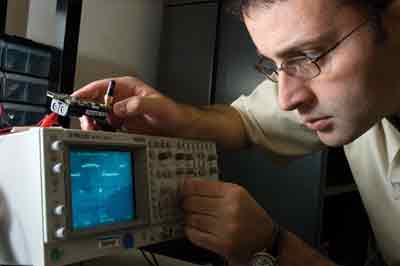
September 08 Issue - Employee Monthly Magazine
Networks of the future
Extending our senses into the physical world

Sami Ayyorgun tests a mote in an experiment aimed at increasing the capabilities of wireless networks across several metrics. Photos by Dixon Wolf
The picture of a future with wireless sensor networks— webs of sensory devices that function without a central infrastructure— is coming into sharper focus through the work of Laboratory computer scientist Sami Ayyorgun of Information Sciences.
Proponents of this new technology see a world with deployments to improve a wide range of operations. Engineers could wirelessly monitor miles of gas and oil pipelines stretching across arid land for ruptures, damage, and tampering. Rescue workers might detect signs of life under the rubble of a collapsed building after an earthquake, thanks to a network of sensors inside the structure. Armed forces could keep an eye on a combat zone or a vast international border via a sensor network that promptly could provide alerts of any intrusion or illicit trafficking.
"Like many other researchers, I think [wireless sensor networks] are likely to rival the impact that the Internet has made in our life."
"It's not easy to envision the impacts that sensor networks will make, both socially and economically," Ayyorgun said. "Like many other researchers, I think they are likely to rival the impact that the Internet has made in our life." Even today, a few companies are beginning to market the technology.
Ayyorgun has developed a new communication scheme that brings the reality of these and other applications a step closer. He has shown for the first time that concurrent gains in many measures of performance are possible, including connectivity; energy; delay, or time it takes for data to be transported; throughput, or the amount of data the system can handle at once; system longevity; coverage; and security.
In recognition of the multifaceted improvements Ayyorgun's research makes on state-of-the-art technology in this field, his recent paper, "Towards a Self-organizing Stochastic-Communications Paradigm for Wireless Ad-hoc/Sensor Networks," has been nominated for the Best-Paper Award from a pool of more than 250 manuscripts at the International Conference on Mobile Ad-hoc and Sensor Systems of the Institute of Electrical and Electronics Engineers.

Sami Ayyorgun's self-organizing communication scheme drives the tiny "motes" of a wireless network to new heights of performance, increasing their versatility in defense, disaster, environmental, and industrial applications.
Like cell phones, wireless sensor networks depend on small, independently powered devices, often called motes, to communicate. But unlike cell phones, which always relay their signal through a base station, such as a tower, sensor motes use each other to relay signals, transmitting communiqués through a series of "hops" from one mote to the next. Foregoing the need to build a mesh of base stations that must be wired or have a substantial supply of energy, creating information-bearing ad-hoc networks to suit each unique set of circumstances would significantly reduce costs.
"Wiring or 'beefing up' system resources is expensive and often is not feasible for many applications," Ayyorgun said, calling that a "major impetus" for wireless network research.
But with nearly all motes dependent on a portable source of power like a battery, it is important that the devices be as energy efficient as possible. "Energy efficiency is a first-class design criterion," he said.
And energy utilization isn't the only consideration. Other performance aspects of concern include the system's connectivity, the delay, the throughput, and network security.
Many solutions aimed at advancing wireless sensor networks have managed to improve performance over at most a few metrics at the expense of others. Ayyorgun analogizes the conundrum to a Rubik's cube, the toy in which the aim is to match each of the six sides with one distinct color. Often, gains in one aspect of wireless sensor network performance, such as energy efficiency, have only been achieved with losses in another area, such as the "end-to-end delay."
With Ayyorgun's scheme, however, "all of the colors have started to match," he said. The sensor network was more energy efficient with shorter delay times, and the other performance considerations all have improved as well.
"The motes communicate randomly, but their random behavior— their genetic code, if you will— has collective intelligence by design," he said. That collective intelligence results in the concurrent performance gains over many areas, he added.
"We have good colors on all sides, but it's not perfect yet," Ayyorgun said, emphasizing that wireless sensor networks still are in the development stage. Many issues remain to be addressed, just as the potential of these networks of the future is being realized.
—John C. Cannon
 |

